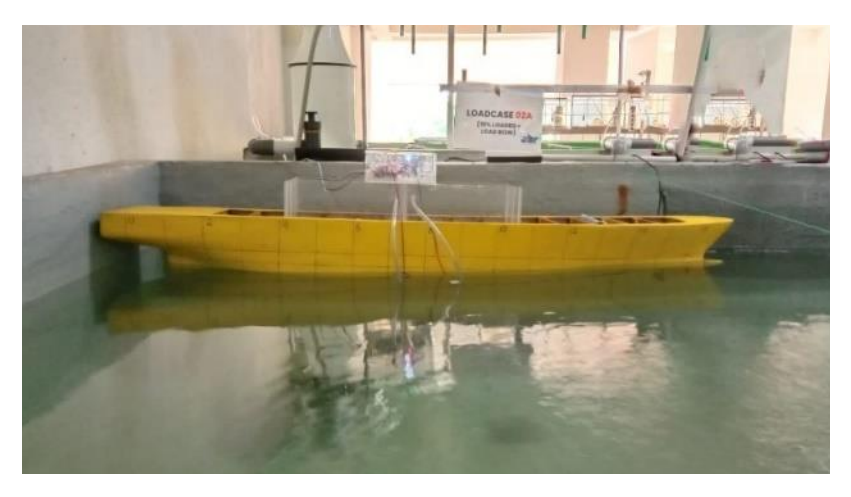Design and Construction of a 8202 DWT General Cargo Ship Test Model for Hydrostatic Testing
DOI:
https://doi.org/10.62012/zl.v4i3.31271Keywords:
Experiment, Hydrostatic, Model-Test, StabilityAbstract
The development of Indonesia's maritime industry cannot be separated from the growth of sea transportation facilities, in this case, namely the growth of the fleet of ships. However, despite this growth, ship accidents are still a crucial issue. One of the causes is sinking caused by poor ship stability. Transfer of cargo on board from loading-unloading activities causes changes in the stability of the ship. In general, ship stability can be analyzed using a numerical approach with hydrostatic analysis, but to accommodate non-linear behavior, model-test experiments are needed. This research focuses on the design of the model test of the General Cargo 8202 DWT ship. The model-test was made with a 1:60 scale which has a model length (L) of 1.80m, breadth (B) of 0.3m, height (D) of 0.23m and a draft (T) of 0.12m. The model-test is designed by modeling the linesplane and then compiling it into a 3D model. Each station on the ship is patterned on wood, cut and arranged to form a ship pattern, then covered with multiplex and fiber. The design procedure for the model-test made refers to the International Towing Tank Conference (ITTC) standard. Pond testing was carried out to identify the draft and inclination of the ship at 3 loading conditions: lightweight, ballasted load and full load. Based on the test results, the model-test’s draft was in accordance with the principal dimensions and the inclination tended to be stable.Downloads
References
P. P. RI, “Peraturan Presiden Republik Indonesia Nomor 2 Tahun 2015 Tentang Rencana Pembangunan Jangka Menengah Nasional (RPJMN) 2015-2019.” Jakarta, 2014.
D. Hubla, “Laporan Tahunan 2020 Direktorat Jenderal Perhubungan Laut.” Jakarta, 2020.
K. N. K. Transportasi, “Statistik Investigasi Kecelakaan Transportasi KNKT 2022,” Jakarta, 2022.
Z. Ren, X. Han, A. S. Verma, J. A. Dirdal, and R. Skjetne, “Sea state estimation based on vessel motion responses: Improved smoothness and robustness using Bézier surface and L1 optimization,” Mar. Struct., vol. 76, no. June 2020, p. 102904, 2021, doi: 10.1016/j.marstruc.2020.102904.
Y. Wang, J. Liu, W. Liu, Y. Liu, and Z. Yuan, “Data-driven methods for detection of abnormal ship behavior: Progress and trends,” Ocean Eng., vol. 271, no. 6, 2023, doi: 10.1016/j.oceaneng.2023.113673.
F. M. Dewadi et al., Desain Penelitian Bidang Teknik. Padang: Get Press Indonesia, 2023.
P. R. of Shipping, “Computer Software for Onboard Stability Calculations.” Gdansk, 2021.
ITTC, “Recommended Procedures and Guidelines, Model Manufacture: Ship Models.” Zurich, 2017.
R. Japri, “Perancangan Konstruksi Profil Pada Kapal General Cargo Dengan Menggunakan Metode Ship Comparative,” Zo. Laut J. Inov. Sains Dan Teknol. Kelaut., vol. 2, no. 2, pp. 26–34, 2021, doi: 10.20956/zl.v2i2.14367.
C. B. Barrass and D. R. Derrett, Ship Stability for Masters and Mates. Oxford: ELsevier, 2012.
M. Martelli and M. Figari, “A design framework for combined marine propulsion control systems: From conceptualisation to sea trials validation,” Ocean Eng., vol. 254, 2022, doi: 10.1016/j.oceaneng.2022.111282.

Downloads
Published
How to Cite
Issue
Section
License
Copyright (c) 2023 Yuni Ari Wibowo, Lulut Alfaris, Anas Noor Firdaus, Nunik Wijayanti

This work is licensed under a Creative Commons Attribution 4.0 International License.
Allow anyone to modify, improve, and make derivative works, even for commercial purposes, as long as they credit to you for the original work.




























